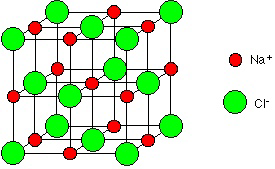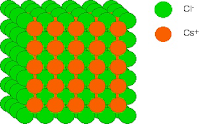AS-Level Chemistry Chapter 5 States of Matter The Solid State
To view other notes related to AS-Level Chemistry. Please Click Here.
The Solid State
Kinetic theory of solids
1) In solids, very strong forces of attraction hold the particles in fixed positions and close to each other. Hence, particles in the solid state can only rotate and cannot translate.
2) A solid has fixed shape and volume.
3) The structure of solids can be crystalline or amorphous.
ii. In amorphous solids, the particles do not have a regular and orderly arrangement. Examples are rubber and plastic.
Ionic lattices
1) An example of ionic lattice is sodium chloride, NaCl, where strong ionic bonds hold the Na⁺ and Cl⁻ ions rigidly in place in the solid lattice.
2) Sodium chloride has a face-centred cubic structure. In this structure, each ion is surrounded by six other oppositely-charged ions. So, sodium chloride is described as 6:6-co-ordinated.
3) Some other examples with face-centred cubic structure are magnesium chloride and magnesium oxide.
4) Another example is caesium chloride, CsCl, which has a body-centred cubic structure. In this structure, each ion is surrounded by eight other oppositely charged ions. So, caesium chloride is described as 8:8-co-ordinated.
5) This is just like layers of oppositely-charged ions stacking on each other.
6) Properties of ionic compounds:
i. They are hard
- This is because the ionic bonds within are very strong. A lot of energy is required to split them apart.
ii. They have high melting and boiling points
- This is because the ionic bonds within are very strong. A lot of energy is required to break the bonds.
iii. They are brittle
- This brings ions with the same charge together and the repulsion between them causes the crystal to split.
iv. They conduct electricity in the molten or aqueous state
- This is because in the molten or aqueous state, free moving ions are present to carry the current.
v. Many of them are soluble in water(polar solvents) but insoluble in non-polar solvents
- This is because when ion-polar solvent attraction is set up, the energy released is enough to compensate the energy needed to break the ionic bonds.
Simple molecular lattices
1) An example of simple molecular lattice is iodine, I2. Solid iodine has a face centred cubic structure.
2) Weak van der Waals' forces of attraction hold the individual iodine molecules together.
3) Properties of simple molecular solids:
i. They do not conduct electricity in any state
- This is because there are no free electrons to carry the current.
ii. They have low melting and boiling points
- This is because the van der Waals' forces of attraction between them is weak, little energy is required to overcome it.
iii. They are soluble in non-polar solvents but insoluble in water(polar solvents)
- This is because the molecule-non-polar solvent attraction set up is enough to compensate the energy needed to break the weak van der Waals' forces of attraction between the simple molecules.
Giant covalent lattices
1) In giant covalent structures, all the atoms are covalently-bonded to each other, linking the whole structure. An example of giant covalent lattice is silicon(IV) oxide or silicon dioxide, SiO2.
2) In silicon dioxide, each silicon atom is covalently-bonded to four oxygen atoms in a tetrahedral arrangement while each oxygen atom is covalently bonded to two silicon atoms in a V-shaped(bent) arrangement.
3) Properties of silicon dioxide:
i. Very high melting and boiling points
- The covalent bonds holding the atoms are very strong, a lot of energy is required to break these strong bonds.
ii. Very hard
- This is because of the need to break the strong covalent bonds
iii. Does not conduct electricity
- This is because there are no delocalized electrons to move around and carry the current. All the electrons are held tightly to the atoms.
4) Another two examples are diamond and graphite. Both of them are allotropes of carbon.
5) Allotropes are different crystalline or molecular forms of the same element in the same physical state, having different atomic arrangement.
6) In diamond, all the carbon atoms undergo sp³ hybridization and covalently-bonded to four other carbon atoms in a tetrahedral arrangement. This network of carbon extends throughout the whole structure.
7) The properties of diamond are same as the ones in silicon dioxide.
8) In graphite, the carbon atoms undergo sp² hybridization. Each carbon atom is covalently-bonded to three other carbon atoms in a trigonal planar arrangement within each layer, forming hexagons.
9) The unhybridized p orbital in each planar layers overlap sideways to form a giant molecular orbital above and below each layer. The electrons are then delocalized, free to move between the layers of carbon. However, the electrons cannot move from one layer to another.
10) The distance between carbon atoms between the layers is greater than the distance between carbon atoms in each layer.
11) Properties of graphite:
i. Very high melting and boiling points
- This is because the covalent bonds holding the carbon atoms with each layer is very strong, a lot of energy is required to overcome the strong forces of attraction.
- In fact, it has a higher melting point than diamond because of the additional attraction between the delocalized electrons and the nucleus. Dispersion forces are also present, this is because the delocalized electrons can set up a temporary dipole easily.
ii. Soft and slippery
- Because of this, graphite is often used as pencil 'leads' and lubricants.
iii. Conducts electricity
- It can conduct electricity in the direction parallel to each layer but not perpendicular to it.
- This is because the delocalized electrons are free to move between the layers but not from one layer to another.
Metallic lattices
1) An example of metallic lattice is copper, Cu. In copper, each copper atom is surrounded by twelve other copper atoms. Therefore, copper is a 12-co-ordinated metal.
2) The copper atoms are bonded to each other through strong metallic bonding.
3) Another example is sodium. In sodium, each sodium atom is surrounded by eight other sodium atoms only. Therefore, sodium is a 8-co-ordinated metal.
4) Properties of metals:
i. High melting and boiling points
- This is because the metallic bonds are very strong, a lot of energy is required to break these strong bonds.
ii. Conducts heat and electricity
- This is because delocalized electrons are present and free to move.
iii. Ductile and malleable
- Metals are ductile(can be pulled into wires) and malleable(can be hammered into different shapes). This is because the layers of metals can slide over each other, the broken metallic bonds can be immediately replaced by the new ones.









